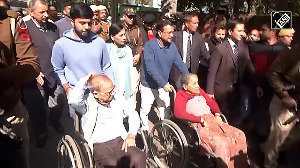The following are the highlights of the 6th Pay Commission Panel report that was submitted to the government on Monday: The 18-month tenure of the Commission was till April 4, 2008.
- Implementation of the revised pay scales from January 1, 2006. Recommendations relating to allowances to be implemented prospectively.
- To remove stagnation, introduction of running pay bands for all posts in the Government presently existing in scales below that of Rs 26,000 (fixed).
- Four distinct running pay bands being recommended one running band each for all categories of employees in groups 'B' and 'C' with 2 running pay bands for Group A posts.
- The posts of Secretary to Government of India/equivalent and Cabinet Secretary/equivalent to be kept in distinct pay scales.
- A separate running pay band, designated as -1S scale, is not to be counted for any purpose as no future recruitment is to be made in this grade and all the present Group D employees not possessing the prescribed qualifications are to be upgraded and placed in the Group 'C' running pay band PB-1 after they are suitably retrained. Group D employees possessing the minimum prescribed qualifications to be placed in PB-1 pay band straightaway.
- Minimum salary at the entry level of PB-1 pay band to be Rs 6660 (Rs 4860 as pay in the pay band plus Rs 1800 as grade pay). Maximum salary at the level of Secretary/equivalent to be Rs 80000. The minimum: maximum ratio 1:12.
- Every post, barring that of Secretary/equivalent and Cabinet Secretary/equivalent to have a distinct grade pay attached to it. Grade pay (being a fixed amount attached to each post in the hierarchy) to determine the status of a post with a senior post being given higher grade pay.
- The total number of grades reduced to 20 spread across four distinct running pay bands; one Apex Scale and another grade for the post of Cabinet Secretary/equivalent as against 35 standard pay scales existing earlier.
- At the time of promotion from one post to another, the grade pay attached to posts in different levels within the same running pay band to change. Additionally, increase in form of one increment to be given at the time of promotion. A person stagnating at the maximum of any pay band for more than one year continuously to be placed in the immediate next higher pay band without any change in the grade pay.
- Annual increments to be paid in form of two and half percent of the total of pay in the Pay Band and the corresponding grade pay. The date of annual increments, in all cases, to be first of July. Employees completing six months and above in the scale as on July 1 to be eligible.
- Another form of variable increments for Group A Pay Band PB-3, where annual increments in the band will vary depending upon the performance. Eighty percent or more employees in the grade to be allowed normal increment at the rate of 2.5% with the high performers (not exceeding 20 per cent) during the year being allowed increment at the higher rate of 3.5%. Government advised to extend the scheme of variable increments in running paybands PB1 and PB2.
The following scheme of revised pay bands is being recommended:
|
(In Rs) | ||||
|
Pre-Revised |
Revised | |||
|
Pay Scale |
Pay Scale |
Pay Band |
Corresponding Pay Bands |
Grade Pay |
|
S-1* |
2550-55-2660-60-3200 |
-1S |
4440-7440 |
1300 |
|
S-2* |
2610-60-3150-65-3540 |
-1S |
4440-7440 |
1400 |
|
S-2A* |
2610-60-2910-65-3300-70-4000 |
-1S |
4440-7400 |
1600 |
|
S-3* |
2650-65-3300-70-4000 |
-1S |
4440-7440 |
1650 |
|
S-4 |
2750-70-3800-75-4400 |
PB-1 |
4860-20200 |
1800 |
|
S-5 |
3050-75-3950-80-4590 |
PB-1 |
4860-20200 |
1900 |
|
S-6 |
3200-85-4900 |
PB-1 |
4860-20200 |
2000 |
|
S-7 |
4000-100-6000 |
PB-1 |
4860-20200 |
2400 |
|
S-8 |
4500-125-7000 |
PB-1 |
4860-20200 |
2800 |
|
S-9 |
5000-150-8000 |
PB-2 |
8700-34800 |
4200 |
|
S-10 |
5500-175-9000 |
PB-2 |
8700-34800 |
4200 |
|
S-11 |
6500-200-6900 |
PB-2 |
8700-34800 |
4200 |
|
S-12 |
6500-200-10500 |
PB-2 |
8700-34800 |
4200 |
|
S-13 |
7450-225-11500 |
PB-2 |
8700-34800 |
4600 |
|
S-14 |
7500-250-1200 |
PB-2 |
8700-34800 |
4800 |
|
S-15 |
8000-275-13500 |
PB-2 |
8700-34800 |
5400 |
*Employees in these scales to be eventually placed in pay band PB-1
|
Pre-Revised |
Revised | |||
|
Pay Scale |
Pay Scale |
Pay Band |
Corresponding Pay Bands |
Grade Pay |
|
New Scale |
8000-275-13500 (Group A Entry) |
PB-3 |
15600-39100 |
5400 |
|
S-16 |
9000 |
PB-3 |
15600-39100 |
5400 |
|
S-17 |
9000-275-9550 |
PB-3 |
15600-39100 |
5400 |
|
S-18 |
10325-325-10975 |
PB-3 |
15600-39100 |
6100 |
|
S-19 |
10000-325-15200 |
PB-3 |
15600-39100 |
6100 |
|
S-20 |
10650-325-15850 |
PB-3 |
15600-39100 |
6500 |
|
S-21 |
12000-375-16500 |
PB-3 |
15600-39100 |
6600 |
|
S-22 |
12750-375-16500 |
PB-3 |
15600-39100 |
7500 |
|
S-23 |
12000-375-1800 |
PB-3 |
15600-39100 |
7600 |
|
S-24 |
14300-400-18300 |
PB-3 |
15600-39100 |
7600 |
|
S-25 |
15100-400-18300 |
PB-3 |
15600-39100 |
8300 |
|
S-26 |
16400-450-20000 |
PB-3 |
15600-39100 |
8400 |
|
S-27 |
16400-450-20900 |
PB-3 |
15600-39100 |
8400 |
|
S-28 |
14300-450-22400 |
PB-4 |
39200-67000 |
9000 |
|
S-29 |
18400-500-22400 |
PB-4 |
39200-67000 |
9000 |
|
S-30 |
22400-525-24500 |
PB-4 |
39200-67000 |
11000 |
|
S-31 |
22400-600-26000 |
PB-4 |
39200-67000 |
13000 |
|
S-32 |
24050-65026000 |
PB-4 |
39200-67000 |
13000 |
|
S-33 |
26000 (fixed) |
Apex Scale |
80000 (fixed) |
Nil |
|
S-34 |
3000 (fixed) |
Cab.Sec./Equ. |
90000 (fixed) |
Nil |
- Defence Forces given running pay bands and grade pay on par with those recommended for civilians.
- In addition, Military service Pay for all personnel of Defence Forces till the rank of Brigadier/equivalent @Rs 6000 pm for officers, Rs 4200 pm for Military Nursing Services officers and Rs 1000 pm for Personnel below Officers ranks. The Military Service Pay to count for all purposes excluding increments.
- Director general (Armed Force Medical services) placed in the Apex grade of Rs 80,000 (fixed)
- In Defence Forces, only two trade groups to be retained for Personnel Below Officer Ranks with the earlier trade groups Y and Z being merged. The personnel in trade group X to have an additional X Group Pay of Rs 1400 per month.
- Certain posts in senior Administrative Grade (SAG) and Higher Administrative Grade (HAG) requiring technical or specialized expertise and not encadred in any of the services to be opened up for being filled bys it able officers within the Government as well as by outsiders on contact. Shift from carrier based to post based selection in the higher echelons of Government in order to get the best domain based expertise.
- Creation of additional posts in senior administrative grade/equivalent/higher grades in future to be strictly on functional considerations with such posts invariably being created outside the cadre to be filled by method of open selection including contractual appointment from within or outside the government.
- Introduction of Performance Related Incentive Scheme (PRIS) in the government under which employees to be eligible for pecuniary remuneration over and above the pay. PRIS to replace ad hoc bonus scheme immediately and eventually replace Productivity Linked Bonus. PRIS to be budget neutral.
- System put in place for giving market driven compensation package to young scientists and posts requiring special expertise and professional skills.
- Parity established between field and secretariat offices.
- The secretariat and stenographers cadres to stand merged in future. All future recruitment in secretariat to be made as executive assistants with minimum qualifications of gradation and one-year diploma in computers. Executive assistants to discharge the functions presently being carried out by assistants as well as the private secretaries.
- Scale of Rs 26,000 (fixed) corresponding to the revised pay scale of Rs 80,000 (fixed).
- Base year of the Consumer Price Index (CPI) for computation of dearness allowance to be revised as frequently as feasible. Formulation of a separate CPI for government employees by National Statistical Commission for computation of dearness allowance suggested.
- Existing rates of most of the allowances to be doubled both in case of Defence Forces as well as civilian employees.
- Existing rate of HRA to be retained for A-1 cities. A, B-1, and B-2 cities to be given this allowance at the higher rate of 20%. C and Unclassified cities to be given the allowance at the higher rate of 10%.
- CCA to be subsumed in Transport Allowance and the rates of this allowance to be increased by 4 times.
- Travel entitlements to be paid on actuals.
- Reimbursement of education allowance to be raised from existing Rs 50 to Rs 1,000 per child per month, subject to a maximum of two children. Hostel subsidy to be raised from existing Rs 300 per month to Rs 3,000 per month.
- Risk allowance to be replaced by risk insurance.
- All fixed allowances made inflation proof with provision of automatic revision whenever dearness allowance payable on revised pay bands goes up by 50%. Transport allowance to be increased every year on the basis of the increase in the dearness allowance.
- Encashment of earned leave in case of defence forces personnel delinked from the number of years of service. All defence forces personnel to be eligible of leave encashment of up to 300 days at the time of retirement/discharge.
- A new medical insurance scheme recommended for government employees. The scheme to be optional for existing central government employees and pensioners. New government employees and new pensioners to be compulsorily covered by the scheme.
- Fitment formula recommended for serving employees to be extended in case of existing pensioners/family pensioners.
- Rates of Constant Attendant Allowance for disabled pensioners to be increased by five times to Rs 3,000 per month.
- Pension to be paid at 50% of the average emoluments/last pay drawn (whichever is more beneficial) without linking it to 33 years of qualifying service for grant of full pension.
- A liberal severance package for employees leaving service between 15 to 20 years of service.
- Higher rates of pension for retirees and family pensioners on attaining the age of 80, 85, 90, 95 and 100 years.
- Revision of the commutation table suggested for commutation of pension.
- In case of government employees dying in harness, family pension to be paid at enhanced rates for a period of 10 years.
- Framing of an appropriate insurance scheme suggested for meeting the OPD needs of pensioners in non-CGHS areas.
- A new mechanism for grant of advances under which an employee will take the advance from an approved bank and the government will give an interest subsidy equal to two percentage points on the rate of interest being charged by the bank to the employee. Existing limits of various advances increased and provisions made for their automatic revision periodically.
- Continuation of five-day week. Government offices to remain closed only on the three national holidays. All other gazetted holidays to be abolished and compensated by increasing the number of restricted holidays from two to eight days in a year.
- Benefits like staggered working hours, special leave for child care, enhanced maternity leave of 180 days, better accommodation facilities in the form of working women's hostels, etc specifically for women employees.
- Government employees with disabilities recommended various benefits like enhanced number of casual leave, special aids and appliances for facilitating office work, higher interest subsidy for automobile loans, liberal flexi hours, higher rate of transport allowance, better prosthetic aids and proper grievance redressal machinery. Extra allowance for disabled women employees to take care of young child till the time the child attains the age of two years.
- Lateral movement of all Defence Forces personnel (both personnel below officer ranks and short service commission officers) at appropriate levels in Central Police Organisations/central Para military Forces as well as to the various posts of defence civilians in the ministry of defence.
- Steps leading to improvement in the existing delivery mechanisms by more delegation, delaying and an emphasis on achieving quantifiable and concrete end results. Emphasis to be on outcomes rather than processes.
- Greater emphasis on field offices/organizations at the cutting edge of delivery
- Enhanced pay scales for nurses, teachers, constabulary and postmen with whom the common citizen has most frequent interaction. Forest guards also to get higher pay scale.
- Better deal for training academies.
- Normal replacement pay band, grade pay and allowances for the existing members of regulatory bodies. A revised method of selection with a higher pay package to those recruited through the revised process of selection in selected organizations.
- All the recommendations to be treated as an organic whole as partial implementation will bring in several anomalies and inconsistencies.
- The recommendations contained in the report to cost Rs 12,561 crore in the year 2008-09. Savings of Rs 4,586 crore likely to accrue on account of various measures suggested in the report. The net financial implications of the recommendations contained in the report estimated to be Rs 7,975 crore for the year 2008-09. an additional, one-time burden of Rs 18,060 crore on payment of arrears.






 © 2025
© 2025